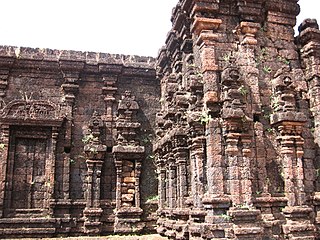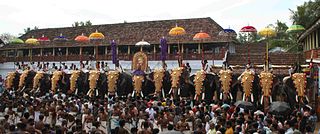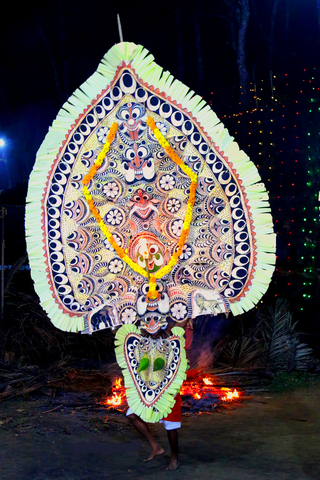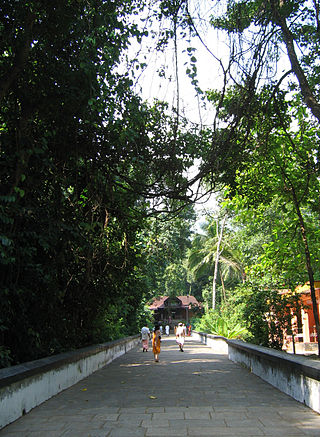
Airavata is a divine elephant, characterized by four tusks, seven trunks and a white complexion. He is the "king of elephants" also serves as the main vehicle for the deity Indra. It is also called 'abhra-Matanga', meaning "elephant of the clouds"; 'Naga-malla', meaning "the fighting elephant"; and 'Arkasodara', meaning "brother of the sun". 'Abhramu' is the elephant wife of Airavata. Airavata is also the third son of Iravati. In the Mahabharata he is listed as a great serpent.

Parassini Madappura Sree Muthappan temple is a temple located at Parassinikadavu in Anthoor municipality on the banks of the Valapattanam river about 10 km (6.2 mi) from Taliparamba and 20 km (12 mi) from Kannur town in Kannur district, Kerala, India. Principal deity of the temple is Sree Muthappan, whose divinity is presented as a ritualistic theyyam enactment in two versions called Thiruvappan and Vellattam. According to the local tradition the presiding deity is a manifestation of Lord Shiva.

The Rajarajeshwara Temple is a Hindu temple dedicated to the Hindu god of dissolution Shiva, located in Taliparamba, Kannur district, Kerala, India. It is considered one of the 108 Shiva Temples of Kerala.

Elephants found in Kerala, the Indian elephants, are one of three recognized subspecies of the Asian elephant. Since 1986, Asian elephants have been listed as endangered by IUCN as the population has declined by at least 50% over the last three generations, estimated to be between 25,600 to 32,750 in the wild. The species is pre-eminently threatened by habitat loss, degradation and fragmentation. Along with a large population of wild elephants, Kerala has more than seven hundred captive elephants. Most of them are owned by temples and individuals. They are used for religious ceremonies in and around the temples, and some churches, and a few elephants work at timber yards.

Sree Poornathrayesa temple is a Hindu temple situated in Thrippunithura, Kochi, the capital of the former Kingdom of Cochin, Kerala, India. The temple is considered among the greatest temples in Kerala and was the first among eight royal temples of the erstwhile Kingdom of Cochin. The presiding deity is Vishnu as Santhanagopala Murthy or Poornathrayeesa. He was the national deity of Cochin and protector guardian of Tripunithura. Poornathrayeesa is known for his love of elephants. Hence more than 40 elephants participate in his Vrishchikotsavam.

Cherpu is a suburb of Thrissur city in the Kerala State of South India. It is 12 kilometres south of Thrissur town and is on the Thriprayar road. It is dotted by a number of temples and has quite a few rivers flowing by its vicinity.

Gaja is a Sanskrit word for elephant. It is one of the significant animals finding references in Hindu scriptures, as well as Buddhist and Jain texts.

The Murugan Temple is a Hindu temple, on the hill of Tiruttani, Tiruvallur district, Tamil Nadu, India, dedicated to Murugan. The hill has 365 steps indicating 365 days of the year. It is fifth among the six abodes of Murugan The other five are Palani Murugan Temple, Swamimalai Murugan Temple, Thiruchendur Murugan Temple, Thiruparankundram and Pazhamudircholai Murugan Temple. Tiruttani is 87 kilometres (54 mi) from Chennai. It is the only adobe located within the Greater Chennai Metropolitan Area limit. During the Sangam era, Tiruttani was known as Kundruthoradal. After killing the asura Tarakasura in Tiruchendur, he came here to subside his anger, so Surasamharam is not conducted here.

Poothan and Thira is a ritualistic folk art performed mainly in the Valluvanad region of central Kerala in India, in which people dance in costumes representing Poothan is the lieutenant of Kali, and Thira, the goddess Kali, to the accompaniment of drummers. Thudi a small drum using for poothan, and heavy drum para accompanying thira.

Kaviyoor Mahadevar Temple is one of the important Siva temples in Kerala, located in Kaviyoor, Tiruvalla Pathanamthitta District, Kerala, India. It is commonly called Thrikkaviyoor Mahadeva Temple. The main deity is Lord Mahadeva (Shiva) with Parvathi.The temple is well known for the Hanuman temple situated inside the temple complex. Kaviyoor Temple is one of the important Special Grade temples under the Travancore Devaswom Board.

Sri Vasudevapuram Temple is one of three ancient temples (Maha-Kshetram) on the Southern bank of holy river Bharathapuzha. It sits east of the other two, Maha-Shiva Temple and Brahma temple. These temples along with the famous Thirunavaya Maha-Vishnu temple across the river form the trilogy in Sanatana Dharma). Tavanur is called Muvaankara (മൂവ്വാങ്കര). Brahma, Vishnu, and Shiva are the presiding deities, so it was initially known as Muvalankara, and then Muvaankara. Vasudevapuram Tavanur is situated in the middle of a wooded area resembling that of Sabarimala.

Ettumanoor Mahadeva temple is an ancient Shiva temple in Kottayam, Kerala, India. The temple is one of the major Shiva temples in Kerala, along with Vaikom Temple, Kaduthruthy Mahadeva Temple, Chengannur Mahadeva Temple, Vazhappally Maha Siva Temple, Ernakulam Shiva Temple, Vadakkunathan temple and Sreekanteswaram Mahadeva Temple, Thiruvananthapuram.

Padayani, also known Padeni, is a traditional folk dance and a ritual art from the central portion of the Indian state of Kerala. A ceremonial dance involving masks, it is an ancient ritual performed in Bhagavati temples. The dance is performed in honor of Bhadrakaali. Meaning, a 'row of warriors', Padayani is an art form that blends all music, dance, theatre, satire, facial masks, and paintings. It is part of worship of Bhadrakali and is staged in temples dedicated to the goddess from mid-December to mid-May. Padayani is unique to central Travancore, comprising the Pathanamthitta and Kottayam districts of Kerala. It is also performed in adjoining regions of Kollam, Alappuzha districts.

The Vigneshwara Temple or Vighnahar Ganapati Temple of Ozar is a Hindu temple dedicated to Ganesha, the elephant-headed god of wisdom. The temple is one of the Ashtavinayaka, the eight revered shrines of Ganesha in Maharashtra, India. The Ganesha form worshipped here is called Vigneshwara or Vignahar and is associated with the legend of Ganesha defeating Vignasura, the demon of obstacles.

The MajorVellayani Devi Temple is a highly revered shrine in Kerala, India, dedicated to goddess Bhadrakali. The shrine is situated in Vellayani 1.5 km west of Vellayani junction, 12 km southeast of Thiruvananthapuram on the eastern bank of Vellayani Lake. The temple is under the management of Travancore Devaswom Board. The temple structure has a bronze roof with traditional art work and carries Dravidian architecture. The temple has eastern and northern towers called Gopurams with statues of different Gods sculptured in them. The Gopurams function as gateways through the walls that surround the temple complex.

Elamgulam Sree Dharma Sastha Temple is a Hindu temple in India, located in the state of Kerala. It is situated on Main Eastern Highway (SH-8) with its landmark temple ground in the village of Elamgulam in Kottayam district. The temple's annual festival features the captivating Gajamela and Aanayoottu ceremonies with around 15 elephants.

Kottiyoor Temple is a prominent Shiva temple in Kottiyoor, Kannur, Kerala, India. It was under the Kattan dynasty of Puralimala, from which the name 'Katti-yoor' originated. This name later evolved into Kottiyoor in the local dialect. Vadakkeshwaram Temple is the common name of the temple from ancient times, but some of the local people address the temple as Ikkare Kottiyoor as it is on the bank of the river close to the Kottiyoor village, to differentiate it from the shrine in the other side of the river. Thruchherumana Kshetram is also another name by which temple is known. The temple is a special category temple under Malabar Devaswom board.

Over the millennia of its development, Hinduism has adopted several iconic symbols, forming part of Hindu iconography, that are imbued with spiritual meaning based on either the scriptures or cultural traditions. The exact significance accorded to any of the icons varies with region, period and denomination of the followers. Over time some of the symbols, for instance the Swastika has come to have wider association while others like Om are recognized as unique representations of Hinduism. Other aspects of Hindu iconography are covered by the terms murti, for icons and mudra for gestures and positions of the hands and body.

Pallimanna Siva Temple is a temple located at Kumbalangad, a small village in Thrissur District, Kerala, India. The temple is located at Kumbalangad - Kanjirakode Road, Vadakkancherry. Archeological Survey of India declared the mural paintings in the walls of this temple as protected monument of national importance since 1983. The main deity in this temple is Lord shiva. The temple is situated in the banks of a small river called aloor river, which is originating from vazhani dam.

Mookambika is a Hindu goddess, an aspect of Adi Parashakti, the supreme goddess of Hinduism. She is regarded to be the form of shakti, the divine feminine energy, that represents creativity and ingenuity. She is widely worshipped in the states of Karnataka, Kerala and Tamil Nadu. Her most important abode is the Mookambika Temple located in Kollur village in Udupi district of coastal Karnataka.
![nerrrrippttttN-prd[?]shnN.JPG](http://upload.wikimedia.org/wikipedia/commons/thumb/b/ba/%E0%B4%A8%E0%B5%86%E0%B4%B1%E0%B5%8D%E0%B4%B1%E0%B4%BF%E0%B4%AA%E0%B5%8D%E0%B4%AA%E0%B4%9F%E0%B5%8D%E0%B4%9F%E0%B4%82-%E0%B4%AA%E0%B5%8D%E0%B4%B0%E0%B4%A6%E0%B5%BC%E0%B4%B6%E0%B4%A8%E0%B4%82.JPG/250px-%E0%B4%A8%E0%B5%86%E0%B4%B1%E0%B5%8D%E0%B4%B1%E0%B4%BF%E0%B4%AA%E0%B5%8D%E0%B4%AA%E0%B4%9F%E0%B5%8D%E0%B4%9F%E0%B4%82-%E0%B4%AA%E0%B5%8D%E0%B4%B0%E0%B4%A6%E0%B5%BC%E0%B4%B6%E0%B4%A8%E0%B4%82.JPG)























![nerrrripttttN-sv[?]nnnnN.JPG](http://upload.wikimedia.org/wikipedia/commons/thumb/9/9c/%E0%B4%A8%E0%B5%86%E0%B4%B1%E0%B5%8D%E0%B4%B1%E0%B4%BF%E0%B4%AA%E0%B4%9F%E0%B5%8D%E0%B4%9F%E0%B4%82-%E0%B4%B8%E0%B5%8D%E0%B4%B5%E0%B5%BC%E0%B4%A3%E0%B5%8D%E0%B4%A3%E0%B4%82.JPG/90px-%E0%B4%A8%E0%B5%86%E0%B4%B1%E0%B5%8D%E0%B4%B1%E0%B4%BF%E0%B4%AA%E0%B4%9F%E0%B5%8D%E0%B4%9F%E0%B4%82-%E0%B4%B8%E0%B5%8D%E0%B4%B5%E0%B5%BC%E0%B4%A3%E0%B5%8D%E0%B4%A3%E0%B4%82.JPG)

![nerrrrippttttN kettttikkunn paappaa[?].jpg](http://upload.wikimedia.org/wikipedia/commons/thumb/b/b0/%E0%B4%A8%E0%B5%86%E0%B4%B1%E0%B5%8D%E0%B4%B1%E0%B4%BF%E0%B4%AA%E0%B5%8D%E0%B4%AA%E0%B4%9F%E0%B5%8D%E0%B4%9F%E0%B4%82_%E0%B4%95%E0%B5%86%E0%B4%9F%E0%B5%8D%E0%B4%9F%E0%B4%BF%E0%B4%95%E0%B5%8D%E0%B4%95%E0%B5%81%E0%B4%A8%E0%B5%8D%E0%B4%A8_%E0%B4%AA%E0%B4%BE%E0%B4%AA%E0%B5%8D%E0%B4%AA%E0%B4%BE%E0%B5%BB.jpg/120px-%E0%B4%A8%E0%B5%86%E0%B4%B1%E0%B5%8D%E0%B4%B1%E0%B4%BF%E0%B4%AA%E0%B5%8D%E0%B4%AA%E0%B4%9F%E0%B5%8D%E0%B4%9F%E0%B4%82_%E0%B4%95%E0%B5%86%E0%B4%9F%E0%B5%8D%E0%B4%9F%E0%B4%BF%E0%B4%95%E0%B5%8D%E0%B4%95%E0%B5%81%E0%B4%A8%E0%B5%8D%E0%B4%A8_%E0%B4%AA%E0%B4%BE%E0%B4%AA%E0%B5%8D%E0%B4%AA%E0%B4%BE%E0%B5%BB.jpg)


